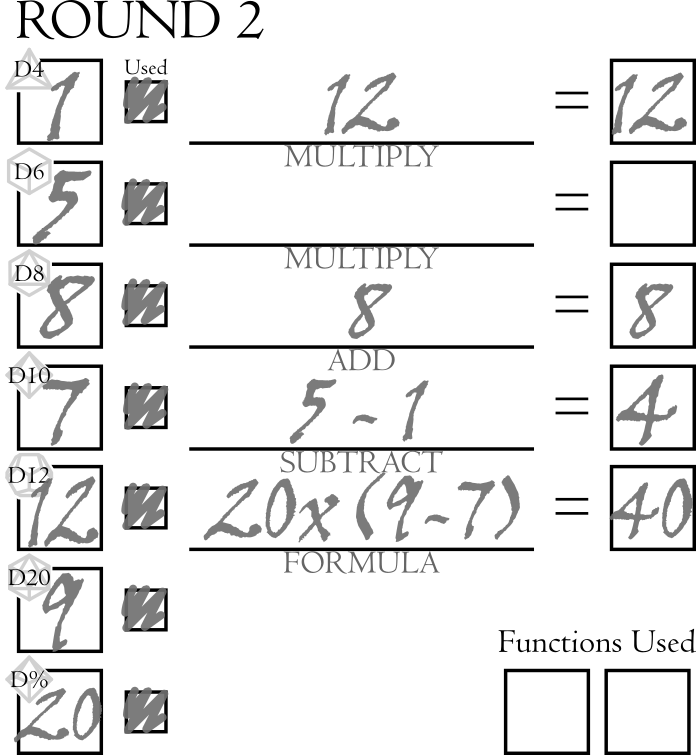Mathematic-roll is a roll & write game about number manipulation and elementary mathematics, perfect for students practicing their addition, subtraction, and multiplication skills while also providing the fun and challenging decision making of a classic competitive roll & write! The game plays over 7 rounds where players roll dice and combine the values with simple math operations to fill in sections of a multiplication table.
Players score points by completing rows and columns in the table, and by cleverly using the values they have to make high-value numbers and patterns. Players can also take advantage of special abilities (functions) to manipulate their rolls, and saving rolls for later rounds to build towards crafting more complicated equations and score higher-value numbers.
This game can be played with any number of players at the same time using a single set of dice. Each player will need to have their own pen or pencil and Player Sheet.
Buy Mathematic-roll Print & Play ($1.99 CAD)
Mathematic-roll is also available free to teachers and educational institutions - please use the Contact link at the top of this page to request an educational copy, including your name and the name of the school, institution, or home-school program that you are affiliated with.
You will receive a printable PDF of the rules and player sheets, and to play you will need to provide your own set of 7 polyhedral dice (1 each of the following: D4, D6, D8, D10, D12, D20, and D%) and a pencil.
If you experience any issues receiving the email or accessing the download link, please use the Contact link at the top of the page to let us know.
Players:
1 or more
Playing Time:
Solo 20m, Group 20-40m
Learning +10-20m
Ages:
8+
Contains:
Printable rules and player sheets (1 sheet per player)
Requires:
1 Pencil
7 polyhedral dice (1 each of the following: D4, D6, D8, D10, D12, D20, and D%)
Gameplay
The purpose of this game is to use dice rolls to form Equations and using the results of those Equations to fill in squares on the Grid. Points are scored by completing rows and columns on the Grid, by filling in clusters of squares that share the same row or column on the Grid in each round, and by choosing to keep the first dice roll values each round instead of using rerolls. The player with the highest total score is declared the winner.
The game plays over 7 rounds, at the end of the 7th round each player calculates their total score and the results are compared to determine the winner. Each round has 3 phases: Rolling Dice, Creating Equations, and Grid Placement.
During Rolling Dice all 7 dice are rolled 3 times, each player choosing which dice to keep after each roll until they have selected 1 value for each type of die. Once finished, during Creating Equations each player uses their kept dice values, unused values from previous rounds, as well as additional constants and functions to craft 5 equations. The answer to those equations are used during Grid Placement to fill in squares of the multiplication table on their player sheet and score points for the round.
At the end of the 7th round, all players total up their points, and the winner is determined.




